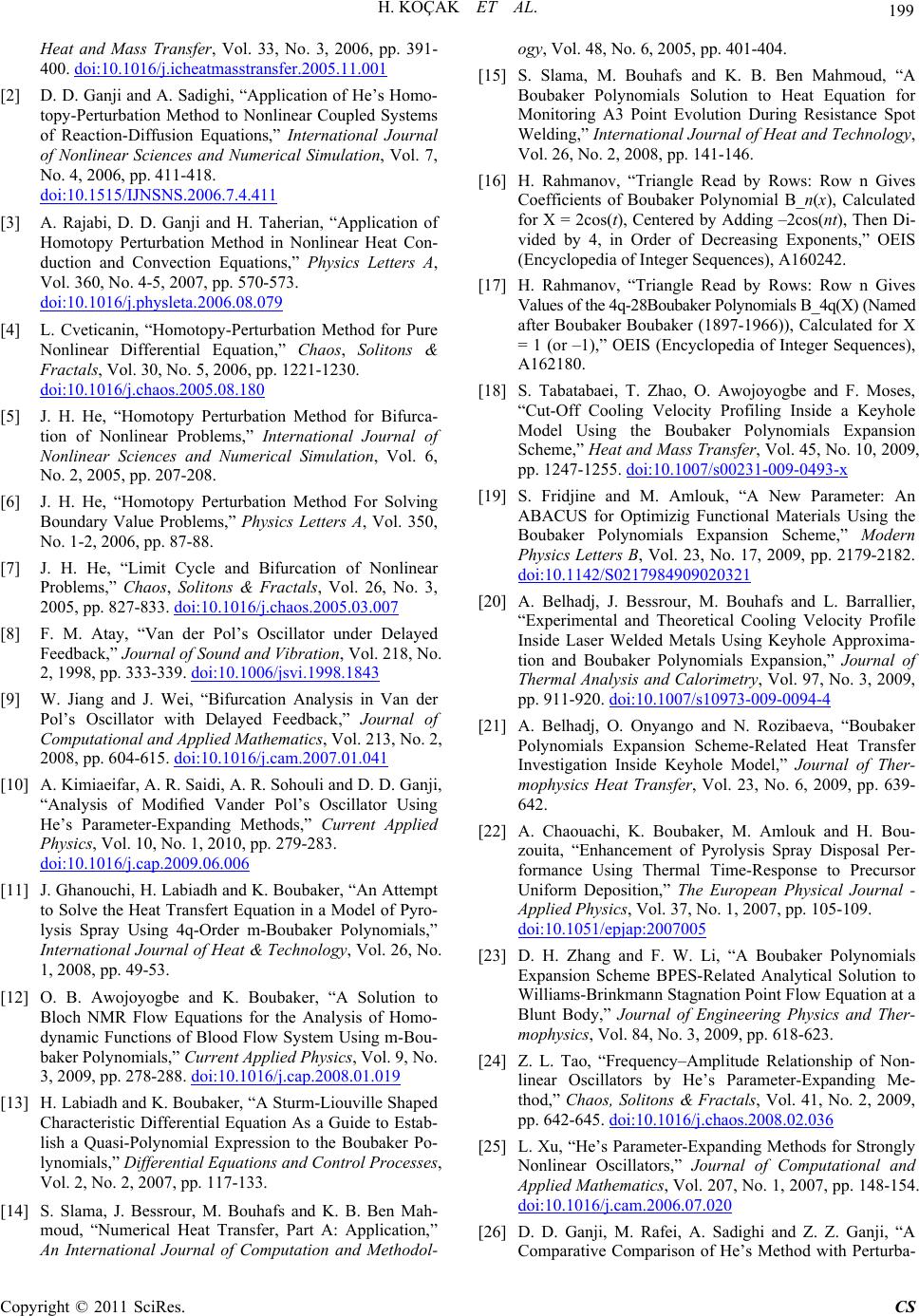
H. KOÇAK ET AL.
199
Heat and Mass Transfer, Vol. 33, No. 3, 2006, pp. 391-
400. doi:10.1016/j.icheatmasstransfer.2005.11.001
[2] D. D. Ganji and A. Sadighi, “Application of He’s Homo-
topy-Perturbation Method to Nonlinear Coupled Systems
of Reaction-Diffusion Equations,” International Journal
of Nonlinear Sciences and Numerical Simulation, Vol. 7,
No. 4, 2006, pp. 411-418.
doi:10.1515/IJNSNS.2006.7.4.411
[3] A. Rajabi, D. D. Ganji and H. Taherian, “Application of
Homotopy Perturbation Method in Nonlinear Heat Con-
duction and Co
Vol. 360, No.
nvection Equations,” Physics Letters A,
4-5, 2007, pp. 570-573.
doi:10.1016/j.physleta.2006.08.079
[4] L. Cveticanin, “Homotopy-Perturbation Method for Pure
Nonlinear Differential Equation,” Chaos, Solitons &
Fractals, Vol. 30, No. 5, 2006, pp. 1221-1230.
doi:10.1016/j.chaos.2005.08.180
[5] J. H. He, “Homotopy Perturbation Method for Bifurca-
tion of Nonlinear Problems,” International Journal of
Nonlinear Sciences and Numerical Simulation, Vol. 6,
No. 2, 2005, pp. 207-208.
[6] J. H. He, “Homotopy Perturbation Method For Solving
Boundary Value Problems,” Physic
No. 1-2, 2006, pp. 87-88.
s Letters A, Vol. 350,
[7] J. H. He, “Limit Cycle and Bifurcation of Nonlinear
Problems,” Chaos, Solitons & Fractals, Vol. 26, No. 3,
2005, pp. 827-833. doi:10.1016/j.chaos.2005.03.007
[8] F. M. Atay, “Van der Pol’s Oscillator under Delayed
Feedback,” Journal of Sound and Vibration, Vol. 218, No.
2, 1998, pp. 333-339. doi:10.1006/jsvi.1998.1843
[9] W. Jiang and J. Wei, “Bifurcation Analysis in Van der
Pol’s Oscillator with Delayed Feedback,” Journal of
Computational and Applied Mathematics, Vol. 213, No. 2
2008, pp. 604-615.
,
doi:10.1016/j.cam.2007.01.041
[10] A. Kimiaeifar, A. R. Saidi, A. R. Sohouli and D. D. Ganji,
“Analysis of Modified Vander Pol’s Oscillator Using
He’s Parameter-Expanding Methods,” Current Applied
Physics, Vol. 10, No. 1, 2010, pp. 279-283.
doi:10.1016/j.cap.2009.06.006
[11] J. Ghanouchi, H. Labiadh and K. Boubaker, “An Attempt
to Solve the Heat Transfert Equation in a Model of Pyro-
lysis Spray Using 4q-Order m-Boubaker Polynomials,”
International Journal of Heat & Technology, Vol. 26, No.
1, 2008, pp. 49-53.
[12] O. B. Awojoyogbe and K. Boubaker, “A Solution to
Bloch NMR Flow Equations for the Analysis of Homo-
dynamic Functions of Blood Flow System Using m-Bou-
baker Polynomials,” Current Applied Physics, Vol. 9, No.
3, 2009, pp. 278-288. doi:10.1016/j.cap.2008.01.019
[13] H. Labiadh and K. Boubaker, “A Sturm-Liouville Shaped
ials Solution to Heat Equation for
ated
mials B_4q(X) (Named
e and F. Moses,
Characteristic Differential Equation As a Guide to Estab-
lish a Quasi-Polynomial Expression to the Boubaker Po-
lynomials,” Differential Equations and Control Processes,
Vol. 2, No. 2, 2007, pp. 117-133.
[14] S. Slama, J. Bessrour, M. Bouhafs and K. B. Ben Mah-
moud, “Numerical Heat Transfer, Part A: Application,”
An International Journal of Computation and Methodol-
ogy, Vol. 48, No. 6, 2005, pp. 401-404.
[15] S. Slama, M. Bouhafs and K. B. Ben Mahmoud, “A
Boubaker Polynom
Monitoring A3 Point Evolution During Resistance Spot
Welding,” International Journal of Heat and Technology,
Vol. 26, No. 2, 2008, pp. 141-146.
[16] H. Rahmanov, “Triangle Read by Rows: Row n Gives
Coefficients of Boubaker Polynomial B_n(x), Calcul
for X = 2cos(t), Centered by Adding –2cos(nt), Then Di-
vided by 4, in Order of Decreasing Exponents,” OEIS
(Encyclopedia of Integer Sequences), A160242.
[17] H. Rahmanov, “Triangle Read by Rows: Row n Gives
Values of the 4q-28Boubaker Polyno
after Boubaker Boubaker (1897-1966)), Calculated for X
= 1 (or –1),” OEIS (Encyclopedia of Integer Sequences),
A162180.
[18] S. Tabatabaei, T. Zhao, O. Awojoyogb
“Cut-Off Cooling Velocity Profiling Inside a Keyhole
Model Using the Boubaker Polynomials Expansion
Scheme,” Heat and Mass Transfer, Vol. 45, No. 10, 2009,
pp. 1247-1255. doi:10.1007/s00231-009-0493-x
[19] S. Fridjine and M. Amlouk, “A New Parameter: An
ABACUS for Optimizig Functional Materials Using the
Boubaker Polynomials Expansion Scheme,” Modern
Physics Letters B, Vol. 23, No. 17, 2009, pp. 2179-2182.
doi:10.1142/S0217984909020321
[20] A. Belhadj, J. Bessrour, M. Bouhafs and L. Barrallier,
“Experimental and Theoretical Cooling Velocity Profile
Inside Laser Welded Metals Using Keyhole Approxima-
tion and Boubaker Polynomials Expansion,” Journal of
Thermal Analysis and Calorimetry, Vol. 97, No. 3, 2009,
pp. 911-920. doi:10.1007/s10973-009-0094-4
[21] A. Belhadj, O. Onyango and N. Rozibaeva, “Boubaker
Polynomials Expansion Scheme-Related Heat Transfer
Investigation Inside Keyhole Model,” Journal of Ther-
mophysics Heat Transfer, Vol. 23, No. 6, 2009, pp. 639-
642.
[22] A. Chaouachi, K. Boubaker, M. Amlouk and H. Bou-
zouita, “Enhancement of Pyrolysis Spray Disposal Per-
formance Using Thermal Time-Response to Precursor
Uniform Deposition,” The European Physical Journal -
Applied Physics, Vol. 37, No. 1, 2007, pp. 105-109.
doi:10.1051/epjap:2007005
[23] D. H. Zhang and F. W. Li, “A Boubaker Polynomials
Expansion Scheme BPES-Related Analytical Solution to
Williams-Brinkmann Stagnation Point Flow Equation at a
Blunt Body,” Journal of Engineering Physics and Ther-
mophysics, Vol. 84, No. 3, 2009, pp. 618-623.
[24] Z. L. Tao, “Frequency–Amplitude Relationship of Non-
linear Oscillators by He’s Parameter-Expanding Me-
thod,” Chaos, Solitons & Fractals, Vol. 41, No. 2, 2009,
pp. 642-645. doi:10.1016/j.chaos.2008.02.036
[25] L. Xu, “He’s Parameter-Expanding Methods for Strongly
Nonlinear Oscillators,” Journal of Computational and
Applied Mathematics, Vol. 207, No. 1, 2007, pp. 148-154.
doi:10.1016/j.cam.2006.07.020
[26] D. D. Ganji, M. Rafei, A. Sadighi and Z. Z. Ganji, “A
Comparative Comparison of He’s Method with Perturba-
Copyright © 2011 SciRes. CS